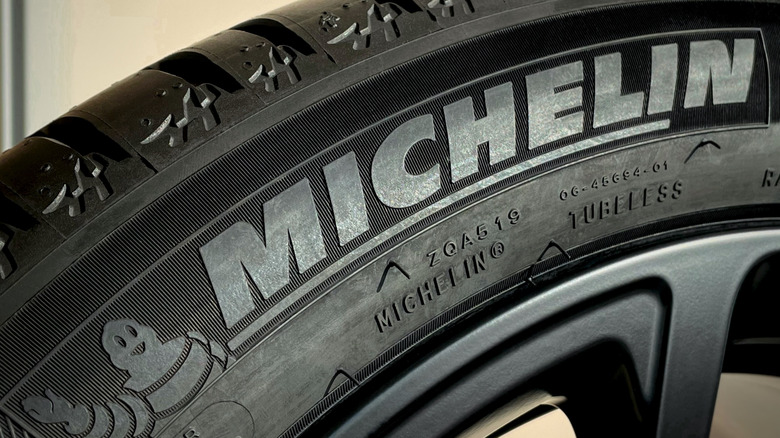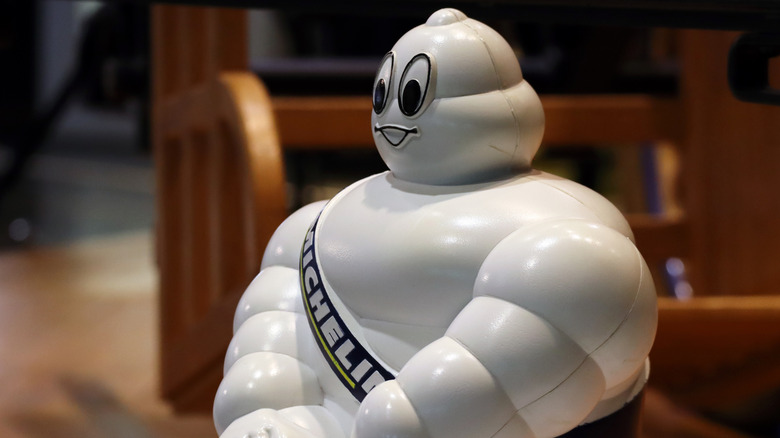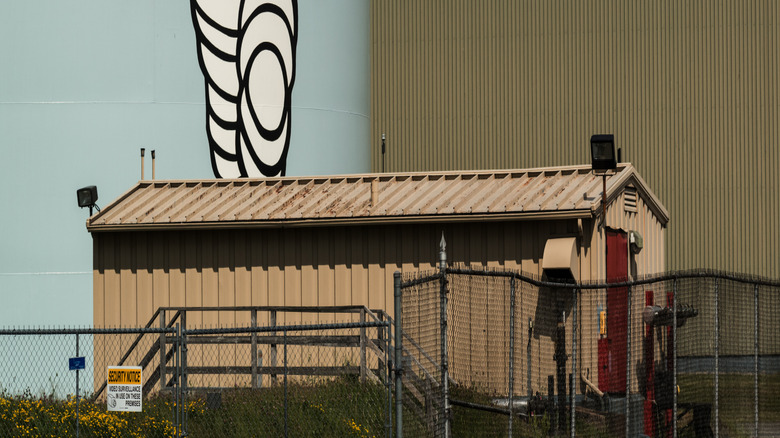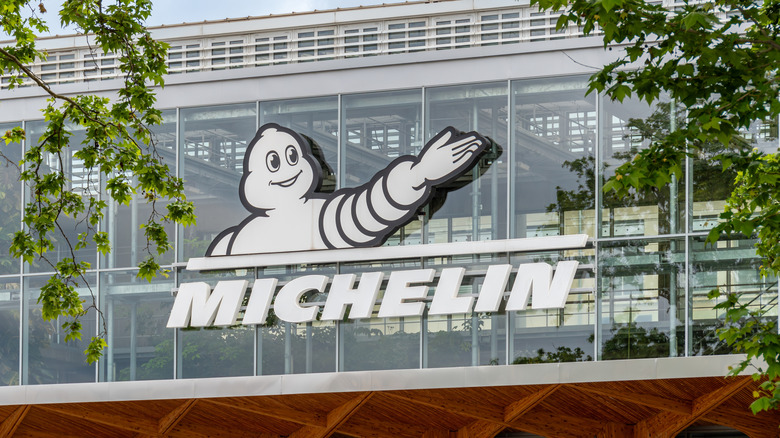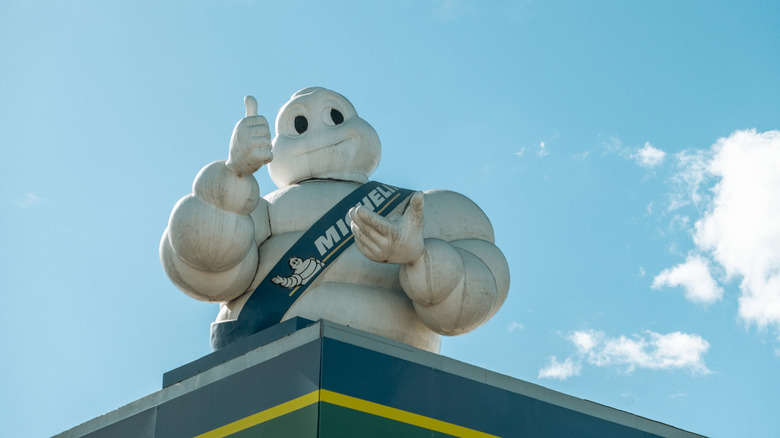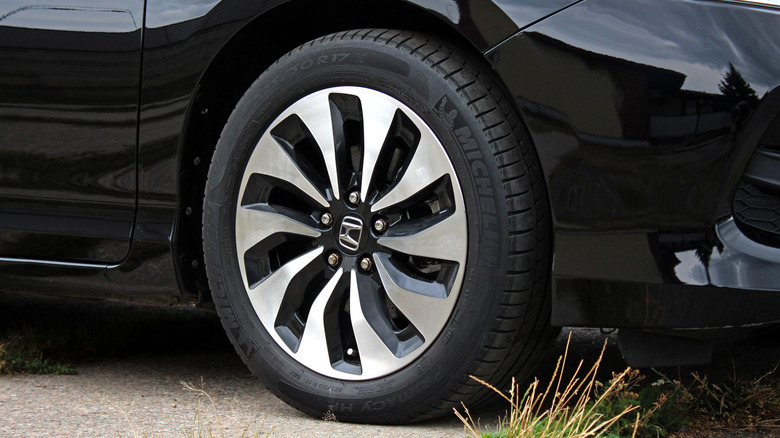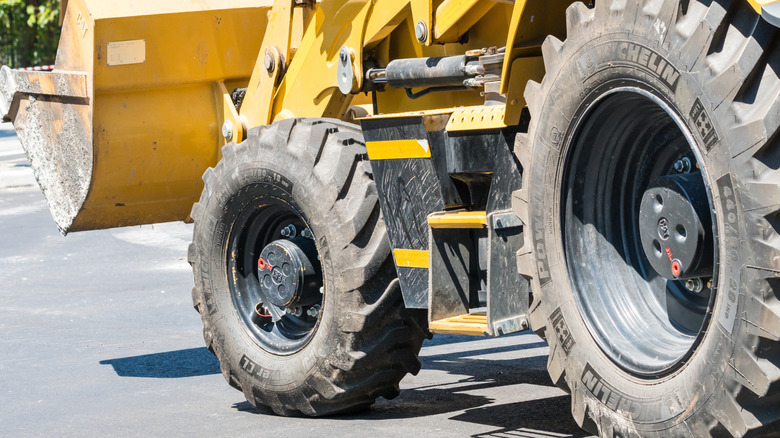Where Are Michelin Tires Made?
Gourmets are most familiar with Michelin as distributors of those coveted restaurant stars, but keen drivers will know Michelin as one of the biggest names in the tire business. Ghostbusters fans will know the brand as the one that has a mascot similar to the Stay Puft Marshmallow Man, but regardless of the context, people tend to know the brand.
Michelin topped SlashGear's ranking of the best tire manufacturers of 2024. It also appears prominently on sales charts, with the Financial Times reporting that the brand achieved an extraordinary €3.6 billion (around $3.9 billion) in segment operating income in 2023. Many drivers, though, will be happily traveling on Michelin tires on simple brand recognition, never seeing the need to dig deeper to learn more about how those tires came to be on their vehicles.
To learn more about what's beneath the surface of the brand's incredible success in the market, we're going to learn who owns the brand and where those famous tires that outfit a huge range of vehicles from planes to construction heavyweights, as well as cars and trucks, are made. It's a huge global operation with bases all over the planet. More than 70 of them, in fact, including offices for research and development as well as manufacturing facilities. Let's see exactly where these tires are made, who owns Michelin tires, and what some of the company's core locations around the world are responsible for.
Who owns Michelin tires?
The Michelin company is a core pillar of the Michelin Group, or Compagnie Générale des Établissements Michelin to its friends. The Michelin Group also has a range of other properties beneath its wide umbrella. These include several companies that are established names in the tire trade, such as Kléber, the first brand the company purchased in 1981. Almost a decade later, in 1990, Uniroyal-Goodrich joined the family too. This incredibly significant deal, The New York Times reported in September 1989, was one worth approximately $1.5 billion. It was a joining of forces that represented, as the newspaper put it, "a deal that will create the world's largest tire company."
This was followed by the addition of more subsidiaries, and the company now owns a sizable portfolio of big names in the auto industry. Another subsidiary is Fenner Precision Polymers. First and foremost, though, the Michelin group is known for its own branded tires, meaning that Michelin itself owns the brand.
The formidable French brand continues to occupy the upper heights of the pecking order, challenged by the likes of the U.S. brand Goodyear and the Japanese giant that is Bridgestone, makers of those special Blizzak tires. In February 2024, CNN reported that Michelin's output totals almost 200 million tires of various types annually. This feat requires a sophisticated logistics chain and a web of worldwide factories, as well as developing much more than just passenger car tires.
Michelin tires in the United States and the Americas
In the United States, Michelin North America, Inc. has its biggest presence in South Carolina. The Palmetto State houses seven different Michelin facilities, including a Spartanburg plant dedicated to creating tires for heavier vehicles like buses and trucks and two more in Lexington and Greenville that manufacture those for smaller vehicles. Six other states have Michelin facilities.
In North Carolina, Asheboro and Norwood plants produce rubber and the necessary materials for retreading tires and airplane tires, respectively. Passenger tires are also produced at plants in Oklahoma and Alabama.
In November 2023, the Oklahoma Business Voice announced that the state's Ardmore facility was set to be closed. The outlet quoted Michelin's Editorial Content Director Eric Bruner as stating, "Unfortunately, this site is not equipped to make the tires that we need at competitive cost to meet the future market demands." Previously that year, Michelin North America had 40 U.S. facilities and a further 10 in Canada, primarily including a prominent Nova Scotia plant developing earthmover and heavy truck tires. Its Canadian HQ is in Quebec's Laval.
In South America, Michelin has had plants in Brazil for almost a century. Though its São Paulo office opened back in 1927, it wasn't until 1981 that a production plant opened there. This was the Rio De Janeiro facility, and it too produces heavy-duty tires for heftier vehicles on the world's roads.
Where are Michelin tires made domestically?
Brothers André and Édouard Michelin founded the company in 1889, in the French town of Clermont-Ferrand. Almost a century and a half has passed since the enterprising brothers began their vehicular odyssey, but the company's global headquarters remains in the town.
In total, there are 19 different Michelin factories and offices across France, from research bases to manufacturing facilities and those exclusively focused on tire retreading. The charming town of Clermont-Ferrand alone boasts the Michelin Group's European Research Center, plus a manufacturing plant where a staff of 700 develop the textile reinforcements and molds needed for Michelin's products. The Cataroux site is the home of a Michelin museum and the production of "metallic reinforcements and semi-finished products," per Michelin. This is one of the oldest of the brand's French locations, having been built in 1921. Clermont-Ferrand also hosts Chantemerle's vast Michelin distribution center, as well as storage of stock and other products (including high-performance tires).
Then, of course, there's the brand's nerve center itself, that famous headquarters. All in all, Clermont-Ferrand continues to be a town vital to Michelin's operations. France, more broadly, is pivotal too. The Bourges factory nestled in the middle of the European nation contains the brand's European Center for Aircraft Tire Retreading, as well as being pivotal to Michelin's aircraft tire production (because tires are about so much more than just cars and trucks). Meanwhile, Roanne boasts a factory that manufactures Ultra High Performance motor vehicle ties.
Michelin's European presence
When Michelin initially branched out from its native France, the company didn't stray too far. Its first non-domestic plant was created for its European neighbor, Italy, in Turin. Completed in 1906, this milestone marked the company as an international enterprise for the first time.
Over a century later, there's something very important to bear in mind about Michelin's various facilities: Their output can be very different. Some big vehicle manufacturers might have very different models in production at the same time at the same factory, but in Michelin's own words, "each Michelin factory is a specialist." As such, the company has a heavy presence in Europe in particular, but each might develop very different tires from the next.
Michelin's plant in Valladolid, Spain, opened in 1973. It was created primarily to manufacture tires for hefty agricultural vehicles such as combine harvesters. It's a role the plant continues to fulfill over 50 years later. The brand already had three other facilities in the country, the first of which opened in Lasarte, in the very north of Spain. This venerable facility, which marked 90 years of production in 2024, served as a multi-purpose producer of various types of tires for several decades of its life, before emerging as a heavyweight of one particular variety: premium motorcycle tires. So critical is the plant to Michelin's global output of such, in fact, that most of its considerable output is exported to other countries.
Michelin's factories in Asia and beyond
Meanwhile, in the East, Michelin has a considerable presence in Asia. In Japan, Ota City in the wider Tokyo Metropolis, has been the setting for a Michelin factory since 1991. One particular plant was closed in 2010, with just-auto.com (via Autoevolution) quoting Michelin at the time that it was committed to "continue to develop its operations and expand its presence in Japan and the Asia Pacific region, notably through its research and development programs in Ota, its sales operations throughout the country and its activities at Nihon Michelin Tire Co Ltd. headquarters in Tokyo."
In the United Kingdom, Michelin's enterprise revolves around the West Midlands city of Stoke-on-Trent. Known for its industrial history, it's perfect for a regional HQ and another facility for retreading tires, this time for trucks. The city even hosts the Michelin Training and Information Center, which provides courses for staff on a range of auto topics, from balancing tires to negotiation techniques for management staff.
In India, the Michelin Technology Center is another important outlet for the company. Its focus is on developing the materials used in the making of tires for larger road vehicles.
Expanding into Africa
Around the middle of the 20th century, Michelin expanded into Africa. Johannesburg's South Africa facility has existed since 1943, and it was in the late 1950s and early 1960s that Société Moderne du Pneumatique Camerounais (in Cameroon's city of Douala) and Michelin Tyre Services (in Nigeria's city of Lagos) were founded.
As in any region, though, Michelin faced its share of challenges on the continent. Historically, Nigeria has hosted its share of tire manufacture, but the company was forced to change tack there in response to what Chioma Alonge, first female Managing Director of Michelin Nigeria, described as "an unfavorable operating environment, power issues and insecurity." Speaking to This Day in 2023, Alonge remembered, "we had our manufacturing plant in Port Harcourt with Lagos as the commercial headquarters." The latter had to close in 2007, she explained, as a result of the country's difficulty maintaining the consistent power that the process of manufacturing tires demanded. The country now maintains an import presence of its tires, as well as a network across the country of facilities focused on distributing and maintaining those tires.
As with any of the world's biggest brands, Michelin's operations have changed shape over time, with some of these facilities closing or changing hands. There's no denying, though, that the Michelin brothers' work all those years ago has led to one of the biggest, more influential and versatile business empires in the world. Its airless tires are the sort of automotive technology that could change the future of driving.
